[英语学习]翻译理论与实践汇编
- 格式:ppt
- 大小:16.83 MB
- 文档页数:57
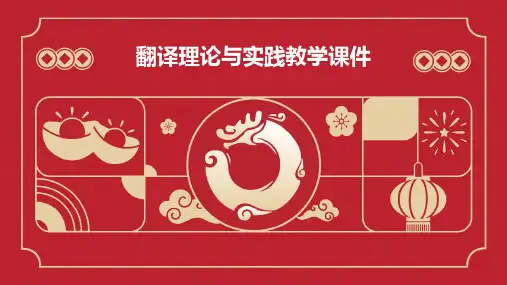
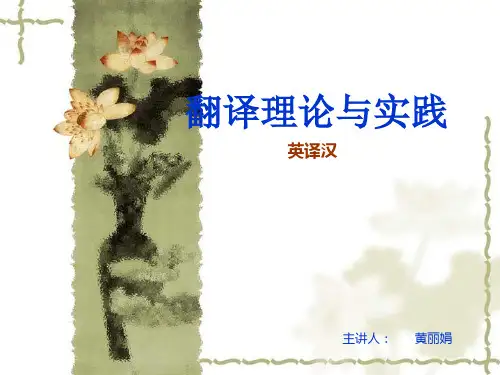
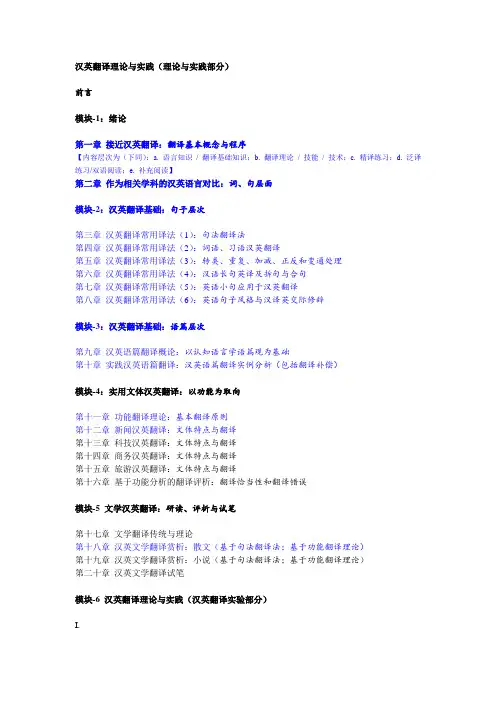
汉英翻译理论与实践(理论与实践部分)前言模块-1:绪论第一章接近汉英翻译:翻译基本概念与程序【内容层次为(下同):a. 语言知识/ 翻译基础知识;b. 翻译理论/ 技能/ 技术;c. 精译练习;d. 泛译练习/双语阅读;e. 补充阅读】第二章作为相关学科的汉英语言对比:词、句层面模块-2:汉英翻译基础:句子层次第三章汉英翻译常用译法(1):句法翻译法第四章汉英翻译常用译法(2):词语、习语汉英翻译第五章汉英翻译常用译法(3):转类、重复、加减、正反和变通处理第六章汉英翻译常用译法(4):汉语长句英译及拆句与合句第七章汉英翻译常用译法(5):英语小句应用于汉英翻译第八章汉英翻译常用译法(6):英语句子风格与汉译英交际修辞模块-3:汉英翻译基础:语篇层次第九章汉英语篇翻译概论:以认知语言学语篇观为基础第十章实践汉英语篇翻译:汉英语篇翻译实例分析(包括翻译补偿)模块-4:实用文体汉英翻译:以功能为取向第十一章功能翻译理论:基本翻译原则第十二章新闻汉英翻译:文体特点与翻译第十三章科技汉英翻译:文体特点与翻译第十四章商务汉英翻译:文体特点与翻译第十五章旅游汉英翻译:文体特点与翻译第十六章基于功能分析的翻译评析:翻译恰当性和翻译错误模块-5 文学汉英翻译:研读、评析与试笔第十七章文学翻译传统与理论第十八章汉英文学翻译赏析:散文(基于句法翻译法;基于功能翻译理论)第十九章汉英文学翻译赏析:小说(基于句法翻译法;基于功能翻译理论)第二十章汉英文学翻译试笔模块-6 汉英翻译理论与实践(汉英翻译实验部分)I.1、翻译技术与资源【实验指导书按单元编写,含实验目的及翻译环境条件、实验构成/过程、实验报告。
】2、汉英翻译基本技巧(1)3、汉英翻译基本技巧(2)4、汉英翻译基本技巧(3)5、汉英翻译基本技巧(4)6、汉英语篇翻译II.1、新闻汉英翻译2、科技汉英翻译3、商务汉英翻译4、旅游汉英翻译5、文学汉英翻译参考译文参考文献。
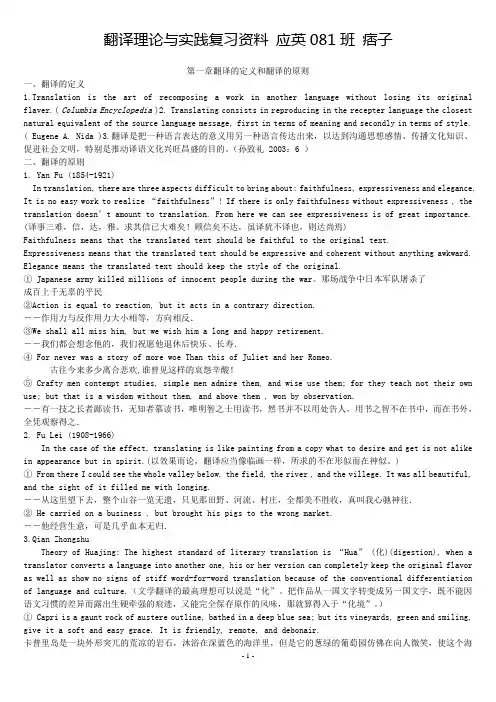
翻译理论与实践复习资料应英081班痞子第一章翻译的定义和翻译的原则一、翻译的定义1.Translation is the art of recomposing a work in another language without losing its original flaver.( Columbia Encyclopedia)2. Translating consists in reproducing in the recepter language the closest natural equivalent of the source language message, first in terms of meaning and secondly in terms of style. ( Eugene A. Nida )3.翻译是把一种语言表达的意义用另一种语言传达出来,以达到沟通思想感情、传播文化知识、促进社会文明,特别是推动译语文化兴旺昌盛的目的。
(孙致礼 2003:6 )二、翻译的原则1. Yan Fu (1854-1921)In translation, there are three aspects difficult to bring about: faithfulness, expressiveness and elegance. It is no easy work to realize “faithfulness”! If there is only faithfulness without expressiveness , the translation doesn’t amount to translation. From here we can see expressiveness is of great importance. (译事三难,信,达,雅。
求其信已大难矣!顾信矣不达,虽译犹不译也,则达尚焉)Faithfulness means that the translated text should be faithful to the original text.Expressiveness means that the translated text should be expressive and coherent without anything awkward. Elegance means the translated text should keep the style of the original.① Japanese army killed millions of innocent people during the war。

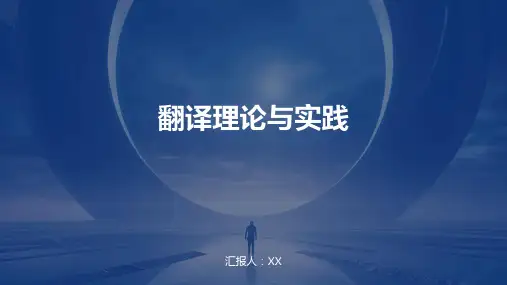
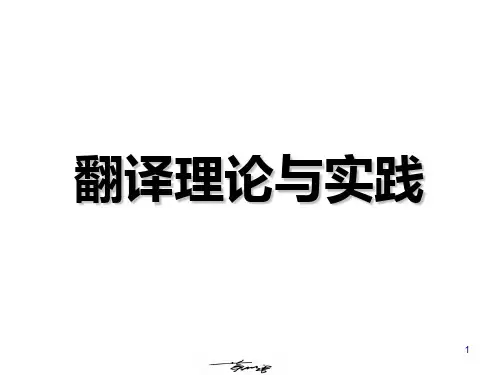
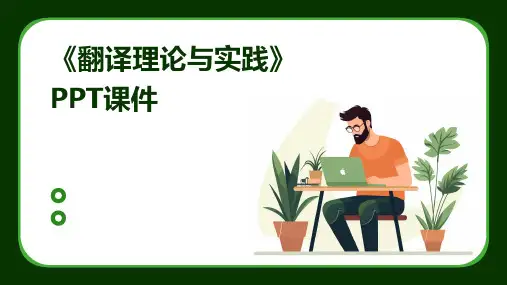
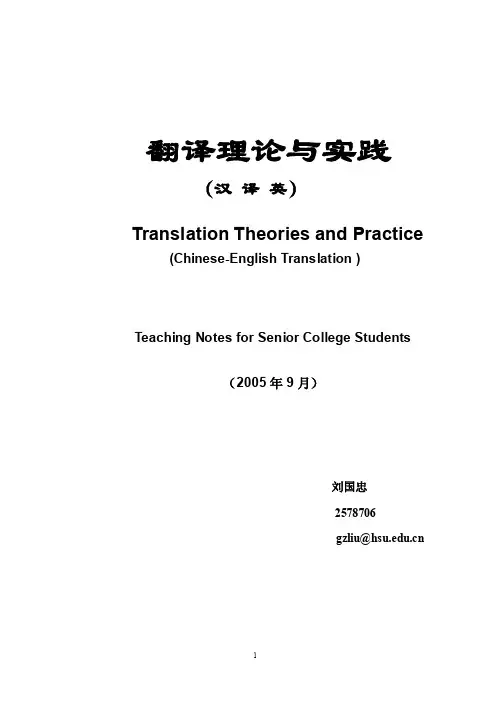
翻译理论与实践(汉译英)Translation Theories and Practice (Chinese-English Translation )Teaching Notes for Senior College Students(2005年9月)刘国忠2578706*************.cnTopics at first:1. 解读汉译英《教学大纲》2. 解读汉译英《考试大纲》3. 汉译英学习指导①重要性②特性③实践性汉译英精典教材:1. 《英汉翻译教程》张培基喻天根《汉英翻译教程》吕瑞昌喻天根上海外语教育出版社 1980.92.《汉英翻译基础》陈宏薇上海外语教育出版社 1998/23.《英汉互译实用教程》宋天锡等国防工业出版社2000/14.《实用翻译教程》(英汉互译)增订本冯庆华上海外语教育出版社2002/55.《实用汉英翻译教程》曾诚外语教学与研究出版社2002/46.《翻译教学:实务与理论》刘宓庆中国对外翻译出版公司2003/1•汉译英主要内容:•一、汉译英实务教学•二、历届TEM8汉译英试卷评析•三、汉译英练习与评析•—汉英翻译强化训练汉译英实务教学主要内容一、汉英词语对比二、汉英句法基本差异(一)汉英句子的主语比较三、汉英句法基本差异(二)汉语谓语动词的分析和翻译四、被动语态的翻译五、汉译英中的主谓定位六、汉译英中的句子整合问题增补内容:七、如何避免翻译中的Chinglish八、汉英翻译中的文化传递九、公示语的翻译十、历届TEM8汉译英试卷评析十一、汉译英练习与评析—汉英翻译强化训练汉译英学习指导(一)如何保证翻译课的教学效果1.以―正当程序‖保证翻译质量无论英译汉,还是汉译英,译文都需要准确、通顺,这是翻译的基本要求。
表达准确的基础是对原文的准确理解:译者必须准确地理解原文的每个词、每句话和作者的意图。
表达通顺的基础是对译入语的熟练运用。
我们在做汉译英时,存在一个天然的劣势:由于英语不是我们的母语,做到表达的准确和通顺相当困难。
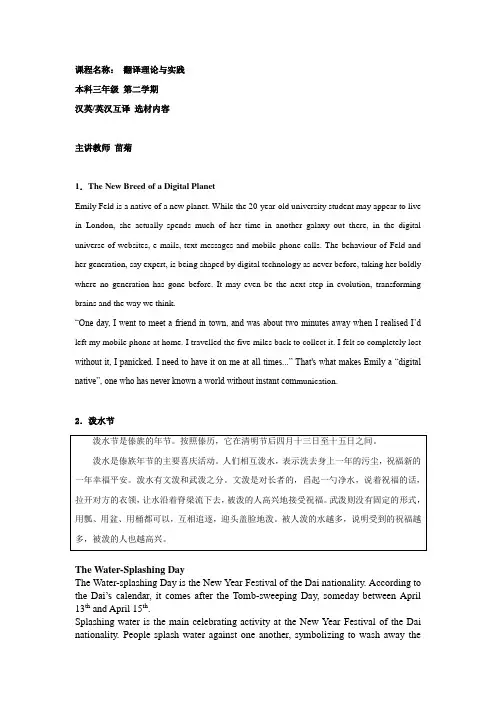
课程名称:翻译理论与实践本科三年级第二学期汉英/英汉互译选材内容主讲教师苗菊1.The New Breed of a Digital PlanetEmily Feld is a native of a new planet. While the 20-year-old university student may appear to live in London, she actually spends much of her time in another galaxy out there, in the digital universe of websites, e-mails, text messages and mobile phone calls. The behaviour of Feld and her generation, say expert, is being shaped by digital technology as never before, taking her boldly where no generation has gone before. It may even be the next step in evolution, transforming brains and the way we think.“One day, I went to meet a friend in town, and was about two minutes away when I realised I’d left my mobile phone at home. I travelled the five miles back to collect it. I felt so completely lost without it, I panicked. I need to have it on me at all times...” That's what makes Emily a “digital native”, one who has never known a world without instant communi cation.2.泼水节The Water-Splashing DayThe Water-splashing Day is the New Year Festival of the Dai nationality. According to the Dai’s calendar, it comes after the Tomb-sweeping Day, someday between April 13th and April 15th.Splashing water is the main celebrating activity at the New Year Festival of the Dai nationality. People splash water against one another, symbolizing to wash away thewhole year’s misfortune and to wish for health and safety in the New Year. There are two ways of splashing water. One is gentle splashing, while the other is free splashing. Gentle splashing is particularly for the elderly. With best wishes, people scoop a ladle of clean water and open the elder’s collar to let the water run down the back. The elderly who is splashed accept the blessings happily. Whereas free splashing has no fixed form, so that any tool such as ladle, basin and bucket are all allowed to be used. People chase after one another and splash water against each other freely. If one is splashed with more water, one feels all the more happy, for it indicates receiving the most wishes.3. MNEThe multinational enterprise (MNE), which is also called multinational corporations (MNC), is one of the major actors in the contemporary international arena, and its worldwide operations are now a decisive force in shaping the patterns of trade, investment, and technology flows among nations. The multinational enterprise system has become so important that it is impossible to understand the world economy without an appreciation of the roles of multinational enterprises as producers, investors, traders, and innovators on a global scale. National governments must also take this force seriously because of its impact on domestic production, employment, trade, and the balance of payments. Moreover, many governments view the multinational enterprises as a political threat, representing an intrusion into the national domain by a company which is controlled by a headquarters located in another country. Even in the United States, which is the home country of more than half of t he world’s biggest multinational enterprises, the multinational enterprise has come under growing attack by labor and protectionist groups who charge it with exporting jobs and technology to the detriment of the U.S. economy.Although multinational enterprise emerged from the world economic arena in the late 19 th century, the multinational enterprise as we know it today developed at an unprecedented speed during the 1950s and 1960s. At that time, dramatic improvements in communications and transportation and the massive liberalization of international trade and payments made it possible for multinational enterprise to operate on a global scale.跨国企业,也称跨国公司,是当今国际舞台上的主要角色之一。

黄山学院外语系课程讲稿专业名称:英语专业课程名称:《英汉翻译理论与实践1》主导教材:冯庆华,《实用翻译教程》授课教师:程汕姗A Brief Introduction to Translation◇Teaching Contents:I.Discussion:●What is translation?●What is a successful translation?●What difficulties might occur in translating process?A.What is translation?1.Key words:source language(SL) / receptor language / target language(TL); reproduce; message /information; equivalence / correspondence2.Nature of translationTranslation consists in reproducing in the receptor language the closest naturalequivalent of the source language message, first in terms of meaning and secondly interms of style. (Eugene A. Nida)德国译学教授Wolfram Wilss 在The Science of Translation:Problems & Methods一书中说:Translation is not simply a matter of seeking other words withsimilar meaning, but of finding appropriate ways of saying things in another language.Translating is always meaning-based, i.e. it is the transfer of meaning instead of formfrom the source language to the target language.(翻译不只是在另一种语言中寻找意义相似的其他词语,而是寻找表达事物的适当方式。
翻译理论与实践(Translation theory and Practice)This paper consists of the 8888 contributionPpt documents may experience poor browsing on the WAP side. It is recommended that you first select TXT, or download the source file to the local view.Translation theory and PracticeI., What, is, translation, II., Is, it, to, translate, easy, III.,, Can, all, the, translated, words, be?I., What, is, translation?1, the definition of translation? 2, translation is to translate the text or? E.g.1:, My, sister, went, to, school, at, 7., e.g.2:, have you eaten? Where to? E.g.3: you're beautiful today! -- where?!II., Is, it, easy, to, translate?Henchman? Go back to man in the? The? Street? Crow s feet a hen party '? Fog lock hill mountain fog water disappears in the sky with rain window, two East West three point cut to carve up the piece, seven horizontal eight vertical knife knife toward the sea towards towards falling towards long clouds long long.III., Can, all, the, words, be, translated?According to the nephew lanterns (old uncle)? East sunrise rain, is (clear) the situation is a (clear)? --The professor shouted:Gentlemen, order --The entire class yelled:! "" Beer! "--Why is the river very? Rich? --Because it has two banks.You can cage a swallow, but you can t swallow a "cage. --The secret is going to? Be exposed, and we ll look pretty silly. --You" already look pretty and silly. bathing on bikini? Girl, eyeing, boy, finds boy eyeing bikini on bathing girl.Chapter 1The definition of translation, the purpose of translation, the type of translation, the standard of translation, the process of translation, the conditions for translationDefinition of translationTranslation is the practice of language in which the content of another language is re expressed in one language. Feng Qinghua? Translation is a kind of language (i.e., primitive) information in another language (the target language) express, so that the readers can get the original thoughts expressed by the author, are roughly the same as the original readers feel. - Fan Zhongying, translation is the translator's re understanding of the same thing and the use of another text. - Qiao HaiqingDefinition of translationTranslation is "an interpretation of verbal signs by means of some other language Translation is." Jakobson? "The replacement of textual material in one language (SL) byequivalent textual material in another language (TL). Catford Translation is the replacement of? A representation of a text in one language by a representation of an equivalent text in a second language. HudsonThe purpose of translationA bridge of communication and communication between different languages and cultures.Types of translationIntra language translation (intralingual translation) an interpretation of verbal signs by means of other signs in the same language (interlingual translation) translation? An interpretation of verbal signs by means of some other language? Intersemiotic translation (intersemiotic translation) an interpretation of verbal signs by means of nonverbal signs systemChinese translation theoriesYan Fu: Xindaya translation - Three: xindaya. It is hard to ask for a letter. Take care of the letter and fail to reach it,Even if you do not translate it, you will also interpret it. ? Lu Xun: faith, Shun - a course to make it easy, one is to preserve the original charm. / / faith rather than fluency? Qu Qiubai: the notion of equivalence translation should be the original intention, exactly China introduced to readers, make readers get China concept concept equal to other language from the textto the reader. Contradiction: to reproduce the artistic conception the highest task of literary translation is to reproduce the artistic conception so that the target readers can enjoy the beauty as much as the original.Chinese translation theoriesLiu Zhongde: letter, reach, cut letter: believe in content: as long as it is cut: to adapt to style, Zhang today: true, good, beautiful, truth: truth, principle, good: ideological principles: Beauty: artistic principlesForeign translation theoriesTytler: 1. The translation should the same effect on give a complete transcript of the ideas of the original work. style and manner of 2. The writing should be of the same character as that of the original. translation should have all 3. The the ease of the original composition.Federov: on Translation should produce a translation version which may be read with as much pleasure as the original, and yet remain faithful to its spirit, sense and style. Nida: dynamic equivalence theory readers get responses, and feelings with the original readers read the original income roughly equal. Newmark: text centered theoryProcess of translationIt is generally believed that the original text is understood expression Nida: original text testAnalytical translationTarget textRestructureFour steps: analysis, translation, reconstruction, testTranslation, from, English, to, Chinese:1., The, days, run, into, weeks., the days go by, for a few weeks.2. It, s, all, Greek, to, me., the translation condition, I do not understand at all. Mandarin Chinese is better than3. Mary has? A clever tongue. Marie (glib glib). English language ability is better than4., You, can, never, tell., wide knowledge, no one can say.5., My, memory, failed, me, at, that, moment., I can't remember that moment.6., Your, name, obstinately, escapes, me., I can't remember your name.7., To, think, that, you, should, fail., I don't think you will fail. 8., Would, it, were, otherwise, if that's not the case. There was more mischief than harm in him. he is only mischievous, and no harm. 10., I, never, go, past, my, old, school, but,, think, of, our, headmaster.. Every time I pass my alma mater, I remember our headmaster. 11., The, book, is, beyond, me., I can't read this book. 12., There, is, nothing, like, leather, for, shoes., leather shoes are great. 13., It, is, too, recent, to, be, forgotten., fresh in memory.14., The, mountain, is, not, valuable, because, it, is, high.,mountain is precious, not at its height. The "This is the last place I where expected to meet you." did not expect to meet you here. 16., He, is, nothing, if, not, stubborn., he's a stubborn man. 17., I, was, not, a, little, surprised., I was shocked.18., He, can, do, it, if, any, one, can., only he can do it.19. You cannot make something out of nothing. one can't make bricks without straw. 20., I, can, t, bear, the, sight,, of, that, man.I can't stand seeing that man.Similar sentences1. He had made a box., he has made a box. He had a box made., he told people to make a box.2. Foolishly he spoke. he was so foolish to speak. He spoke foolishly. he talks very stupid.3. Quite properly he was punished. he deserved to be punished. He was punished quite properly., he was properly punished.4., We, asked, him, to, speak, from, his, experience., we ask him to talk about it based on his experience. We asked him to speak about his experiences. we asked him to talk about his experience.Similar sentences5. He is behind time. he's late. He, is, behind, the, times., he's behind the times.6. His success is out of question. his success is beyond doubt. His, success, is, out, of, the, question, he's never going to be successful.7., They, went, to, sea., they're going to besailors. They, went, to, the, sea., they went to the beach. 8., It, has, been, raining, continually, for, two, days., rain, intermittent two days. It has, been, raining, continuously, for,, two, days rain continued for two days.Similar sentences9., He, has, no, more, than, ten, books., he has only ten books. He has not more than ten books., he has ten books at most.He is not a little afraid of it. he was very scared. He is not a bit afraid of it., he is not afraid at all. 11., I, didn, t, go, because, I, was, afraid., I am not afraid to go. I, didn, t, go, because, I, to., was, afraid, I did not go, because I dare not go. 12. She kept the house., she watches over the house. She kept house. her home.Similar sentences13., This, is, no, place, for, me, to, go., this is not whereI should go. There, is, no, place, for, me, to, go, I have nowhere to go. 14. I, had, a, good, talk, to, him, yesterday., I gave him a good dressing down yesterday. I had a good talk with him yesterday. I had a really good time talking to him yesterday. 15., Tom, escaped, prison., Tom escaped the jail. Tom, escaped, from, prison., Tom, jailbreak. 16., Is, there, any, difficulty, in, this? Do you have any difficulty with this? Is, there, some, difficulty, in, this? It's a bit difficult, isn't it?Similar sentencesWe are sure that man is mortal. we are sure that man will always die. We, are, sure, that, man, is, dead., we are sure the man is dead. 18., We, hired, the, boat, by, the, hour.. We ship by hour. We hired, the, boat, for, an, hour., we rented an hour boat.Similar sentences19., I, did, not, notice, him., I didn't notice him. I, took, no, notice, of, him., I don't care about him. 20., Happily, he, did, not, die., thankfully he did not die. He did not die happily., he died uneasy.The second chapter is semantic translationFirst, the choice of meaning in the understanding of polysemy (polysemy)The translation of runRun, a, car, run, shop, run, oil, run, message, a, fever, run, a, computer, run, run, a, meeting, run,, chickens, run, a, arms, advertisement, run, anHead translation10. He arranged his speech under five heads. his speech is divided into five parts. 11., We, have, thirty, head, of, cattle.We have thirty cows. 12., Heads, or, tails? Heads or tails? 13., Where, is, the, head? Where is the toilet?The translation of head:1. head of the English Department, director of the English Department of2. head of the government head of the bed, head of government3.4. head of the staircase a of the needle at the top of the stairs5. head6. He was badly wounded in a the head. he was badly wounded in the head.7. He has a good head for maths. he has a lot of mathematical talent.8., You, should, use, your, head., you should use your head.9. The, dinner, cost, US, five, dollars, a, head., the meal cost us 5 yuan each.The translation of I. poor:1. The, cloth, is, poor, in, quality., this cloth is of poor quality.2. The, water, is, poor, in, oxygen., this water is anoxic.3. Her first concert had a poor audience., her first concert, with very few listeners.4. This, to, her, was, a, poor, consolation., this comfort does not work for her.5. In my poor opinion, you should let her go. in my humble opinion, you should let her go. Boat. She was a poor sailor and always went to bed immediately on on getting the she has seasickness problems, so always go to bed on board.The translation of II. runThe He will not be running in the next election., he is not ready to run for the next election. 2., The, train, is, not, running, today., that train is off today. 3. The film began to run. filmat the. 4. His face was running with sweat. he Sweat streamed down the face. 5., It, was, such, a, ran., hot, day, that, the, butter, the weather was so hot that the butter melted. 6., The, road, runs, north., this road extends north. The "The rumor runs that he is going to resign." is rumoured that he is going to resign. 8., The, monsoon, had, six, weeks, more, to, run., the rainy season will last six weeks.The translation of II. run9., The, car, repair, will, run, you, at, least, two, hundred., repair, at least you spend two hundred yuan. 10. The play ran for only a week in that theatre.. The play was only staged for a week in that theater. 11., Potatoes, are, running, large, this, year., potatoes grow a lot this year. 12., A, freezer, doesn, run., t, cost, much, to, the use of the refrigerator is not very expensive.The translation of III. liveShe needs to find somewhere to live. she needs to find a place to live. 2., Where, do, these, plates, live? Where are these dishes? 3., Spiders, can, live, for, several, days, without, food., spiders can live without food for a few days. 4., We, saw, a, real, rattlesnake, live! We saw a live rattlesnake.The translation of III. live5. The club has live music most nights., the club has live music most nights.6. The show is going on live., the show is being broadcast live.7., Pollution, is, still, very, much, a, live,issue. pollution is still a very interesting issue at the moment.8., This, is, a, live, and, interesting, book., this is a lively and interesting book.The translation of IV. like1., He, likes, mathematics, more, physics., than, he prefers mathematics to physics.2., Bananas, don, t, like, me., I ate a banana and my stomach was upset. (bananas do not fit my stomach.) Three它的味道像芒果。